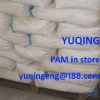- Other Chemicals[1]
- Polymer[9]
- Other Agriculture Products[1]
- Wheat[2]
- Gluten[1]
- Sulphate[10]
- Chloride[10]
- Water Treatment[10]
- Chemical Auxiliary Agent[9]
- Organic Salt[8]
- Organic Acid[3]
- Phosphate[2]
- Alkali[4]
- Contact Person : Ms. Yin Linda
- Company Name : Gongyi Yuqing Water Purifying Materials Co., Ltd.
- Tel : 0086-371-65528428
- Fax : 0086-371-65528428
- Address : Henan,Gongyi,Nanhedu Industrial Zone, Gongyi City, Henan Province. China
- Country/Region : China
- Zip : 450045
PAM Cation
PAM Cation
Analysis of the project/molecular weight(10000) | ≥500 | ≥600 | ≥700 | ≥900 |
Ion degrees | 25-45 | 45-55 | 55-60 | 35 |
Solid content % | 90±2% | 90±2% | 90±2% | 90±2% |
Hydrolysis degree % | 20-25 | 20-25 | 20-25 | 35 |
Residual Monomers | ≤0.02 | ≤0.02 | ≤0.02 | ≤0.02 |
Dissolution time | ≤2h | ≤2h | ≤2h | ≤2h |
Appearance | White particles | White particles | White particles | White particles |
Substance Name: PolyacrylamideCAS Number: 25085-02-3Synonyms: Cationic polyacrylamide, Hydrolyzed cationic polyacrylamideChemical Family: Polyacrylamide
Introduction of cationic PAM
Cationic polymer flocculant is a water soluble linear polymer, and its molecular weight is between 400-1200million. It also can be dissolved in methanol and ethanol, but can not be dissolved in ketones, esters, hydrocarbons and other organic solvents. Cationic CPF showed electropositive in acidic or alkaline medium, thus it is effective in the treatment of coagulation and sedimentation with the suspended particles in the negatively charged sewage water. Such as the production of grain alcohol wastewater, papermaking wastewater, wastewater of urban sewage treatment plants, beer-production wastewater, wastewater of monosodium glutamate factory, sugar-production wastewater, high content of organic wastewater, beverages-production wastewater, and printing and dyeing wastewater. In addition, cationic cpf also can be used as chemicals in oilfield, such as clay anti-swelling chemicals and thickening chemicals used in oilfield acidification, as well as enhancer chemicals used in papermaking.
The product is copolymerized by the cationic monomer (DM, DMC, DMDAAC, DMAEMA) and acrylamide, after granulation, drying and crushing, it appears as a small white powder or small particles.
PAM Cation









